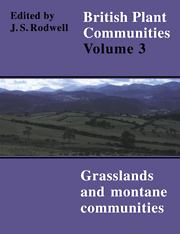Book contents
- Frontmatter
- Contents
- List of Figures
- Preface and Acknowledgements
- Preamble
- Mesotrophic Grasslands
- Community Descriptions
- Calcicolous Grasslands
- Community Descriptions
- Calcifugous Grasslands and Montane Communities
- Community Descriptions
- Index of Synonyms to Grasslands and Montane Communities
- Index of Species in Grasslands and Montane Communities
- Bibliography
CG11 - Festuca Ovina-Agrostis Capillar Is-Alchemilla Alpina Grass-Heath
Published online by Cambridge University Press: 04 July 2020
- Frontmatter
- Contents
- List of Figures
- Preface and Acknowledgements
- Preamble
- Mesotrophic Grasslands
- Community Descriptions
- Calcicolous Grasslands
- Community Descriptions
- Calcifugous Grasslands and Montane Communities
- Community Descriptions
- Index of Synonyms to Grasslands and Montane Communities
- Index of Species in Grasslands and Montane Communities
- Bibliography
Summary
Synonymy
Alpine pasture Smith 1900; Arctic-Alpine grassland Smith 1911 p.p.; Alchemilleto-Agrosto-Festucetum McVean & Ratcliffe 1962; Species-rich Agrosto-Festucetum McVean & Ratcliffe 1962 p.p.; Achilleo-Festucetum tenuifoliae Birse & Robertson 1976 p.p.; Montane Festuca vivipara-Agrostis canina grassland Ratcliffe 1977p.p.; Alchemillaalpina-Festuca-Vaccinium nodum Huntley 1979 p.p.;
Constant species
Agrostis capillaris, Alchemilla alpina, Anthoxanthum odoratum, Festuca ovina/vivipara, Galium saxatile, Nardus stricta, Potentilla erecta, Thymus praecox, Vaccinium myrtillus, Hylocomium splendens.
Rare species
Alchemilla filicaulis spp. filicaulis, A. wichurae, Cerastium alpinum, Diphasium alpinum, Juncus trifidus, Luzula spicata, Minuartia sedoides, Omalotheca supina, Polystichum lonchitis, Potentilla crantzii, Sibbaldia procumbens, Barbilophozia lycopodioides, Herbertus stramineus, Lophozia obtusa, Mastigophora woodsii.
Physiognomy
Generally speaking, it is the prominence of Alchemilla alpina which gives the Festuca-Agrostis-Alchemilla swards their distinctive stamp. It is often the most abundant species present and the low cover of leaves produced from its creeping branches makes the epithet ‘grassland’ somewhat inappropriate for the vegetation. A number of grasses are, however, frequent and abundant and they often comprise the bulk of the sward between and among the A. alpina plants. Agrostis capillaris and Festuca ovina (F. tenuifolia in Birse & Robertson 1976 and Birse 1980) are the commonest species throughout, though F. vivipara here becomes almost as frequent as the latter and sometimes as abundant. F. rubra, however, is less common than in the closelyrelated Festuca-Agrostis-Thymus grassland. Anthoxanthum odoratum and Nardus stricta are also very frequent, though their abundance varies between the two sub-communities. Other grasses occasionally recorded are Deschampsia cespitosa, D. flexuosa and Agrostis canina.
The floristic shift among the sedge component visible in moving from the lowland calcicolous swards through the Sesleria-Galium grassland into the Festuca-Agrostis-Thymus grassland continues here. Carex flacca and C. caryophyllea are now no more than occasional and, though C. pulicaris and C. panicea are frequent and especially distinctive of one of the sub-communities, the commonest species overall are C. pilulifera and, more occasionally, C. binervis. C. bigelowii is scarce but sometimes locally prominent. In general, however, sedges do not make a major contribution to the vegetation cover, occurring usually as scattered shoots within the sward.
- Type
- Chapter
- Information
- British Plant Communities , pp. 246 - 253Publisher: Cambridge University PressPrint publication year: 1992

